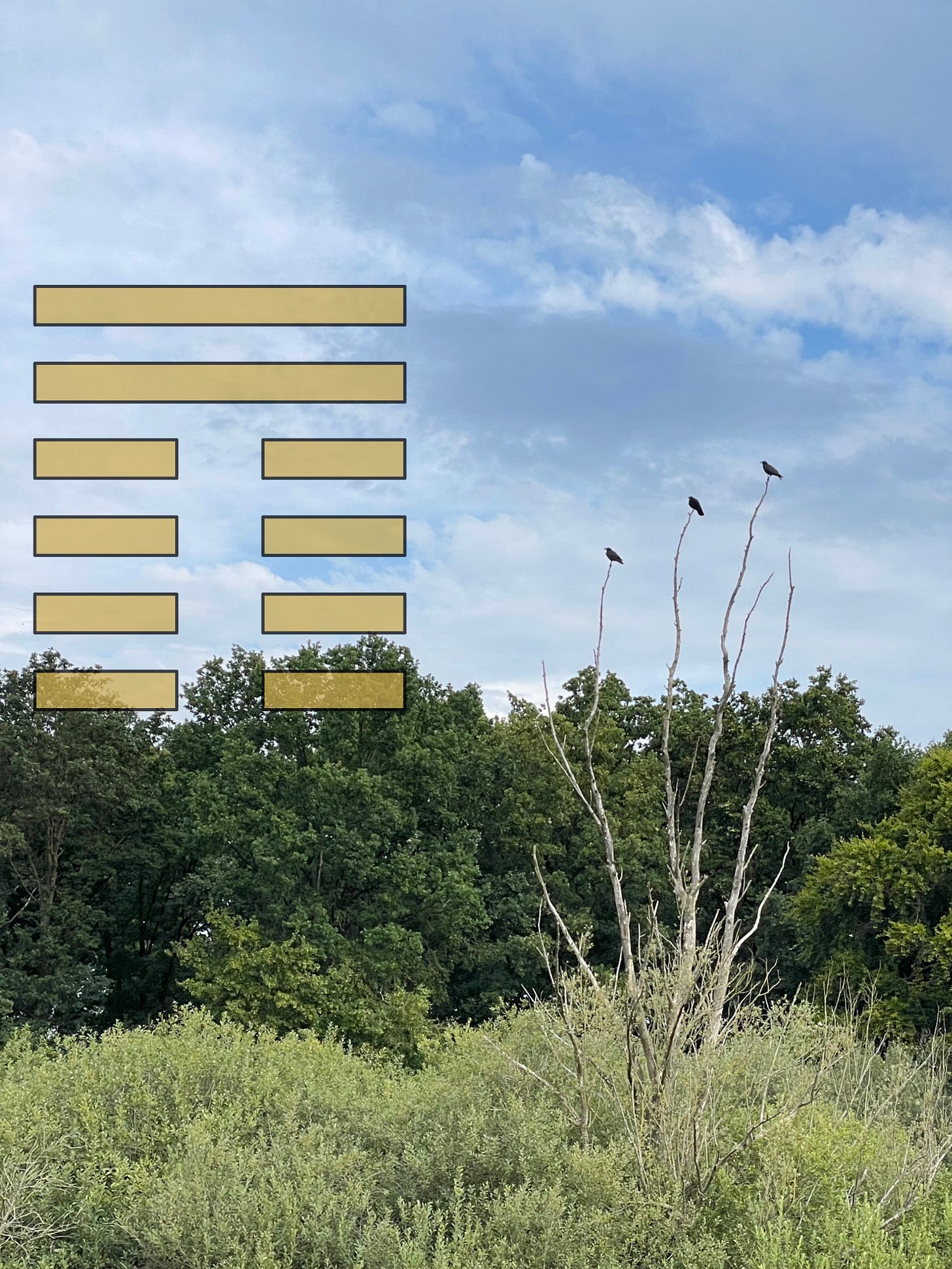Below is the rewritten version of the article that appeared in August 2024.
THE IMAGE of the two trigrams: below the Earth, above the Wind. Wind is wind. Penetrating and unwavering. Wind is wood, plants, greenery and trees, everything that grows steadily. Wind above Earth: a tree on a plain, the tallest tree in the forest. Climb into it, and you have a view, an overview, a horizon. Look around you and you know where your life is. People built watchtowers and crow’s nests, jealous of the perspective of birds. Three of them are now sitting high in the crown of a tree. Wind over Earth: the image of Observing.
Seen from below, the church tower is imposing; the higher it was, the greater the status of the medieval community. Yet the importance of the tower lay elsewhere. It lay in the hitherto unknown perspective it offered to those who took the trouble to climb it. The perspective of clouds, raindrops and seagulls, the perspective of a deceased parent looking down on your daily well-intentioned fuss and fiddling, the perspective of the wind.
From a medieval church tower to a lighthouse and a construction crane, to a skyscraper. One thing after another. The initial expansion of consciousness – seeing the living environment from an even greater height – soon lost its hue. The initial sensation faded. The first time I experienced the take-off of an aeroplane as a passenger, which was a spectacular happening at the time, I was perhaps even more astonished by my fellow passengers who were routinely and impassively reading their newspapers. I would cling to the window like a child and see – as if for the first time – my city, the countryside, the coast, the clouds, the light. Since then, I have flown hundreds of times, and the wonder of the grand perspective quickly wore off.
At last, leaving the earth altogether, leaving the atmosphere, freed from Earth’s gravity. Numerous returning space travellers have testified to their changed perspective on existence after seeing Earth from such a great distance. Before departure, they had expected to make full use of the opportunities offered by being in the space station to gaze further into infinity, but they instinctively turned their heads back to Earth and could hardly take their eyes off it.
Edgar Mitchell (Apollo 14; 1971) described it as an ‘explosion of awareness' and an ‘overwhelming sense of oneness and connectedness... accompanied by an ecstasy... an epiphany’.
William Shatner (Blue Origin NS-18, 2021) said immediately after landing that, ‘Everybody in the world needs to do this. ... The covering of blue was... the sheet, this blanket, this comforter of blue that we have around us... And then suddenly you shoot through it... as though you whip off a sheet off you when you’re asleep, and you’re looking into blackness, into _**black ugliness,**_ and you look down. There’s the blue down there, and the black up there and it’s... There is mother, and Earth, and comfort. And there is—is _there_ death? I don’t know. It was so moving to me. This experience, it’s something unbelievable.’
Ed Dwight (Blue Origin NS-25, 2024) reflected after his suborbital spaceflight: ‘Out the window, I could see the Earth. Everything looked ordered and neat and wonderful and beautiful. There was no separation between countries or states. And you ask yourself: As wonderful as it all is, why can’t the people who live on it get along? Why don’t they want to take care of such a beautiful place?’
THE IMAGE of the two trigrams: Wind above, Earth below. A gentle breeze blowing across the earth. It touches everything, but leaves things as they are. Wind over Earth: the image of Observation. Perceiving things as they are and not as you would like them to be. Does objective perception exist? Can you touch without any ulterior motive – like the wind? Is that even possible for a human being?
The big goes hand in hand with the small. Get closer to yourself, soften the tendency to always want to be somebody else, posses something else, get rid of unnecessary baggage and you will immediately create space to observe more freely. The content of chapter 18. Decay (or Working on Decay) leads to that of chapter 19. Approaching, which in turn gives access to the content of this chapter 20. Observing.
to be continued …







Thanks for this reflection on chapter 20, Overview. On a rather grey October day in the UK, it wonderfully provides a very different perspective of our world as an interconnected whole travelling in space and nicely compliments the book 'Orbital', which I've just finished.